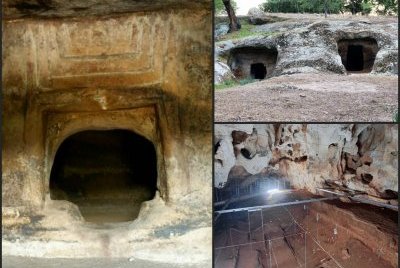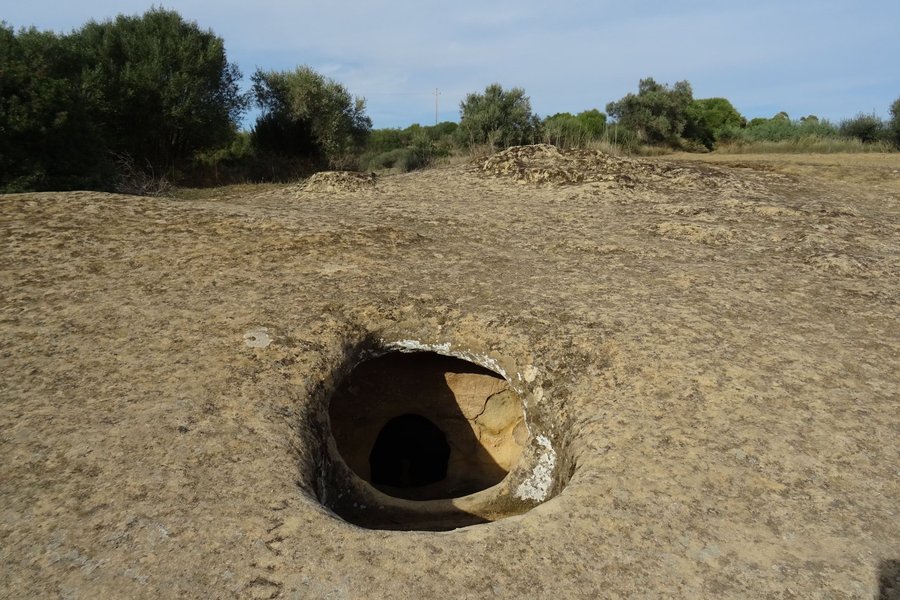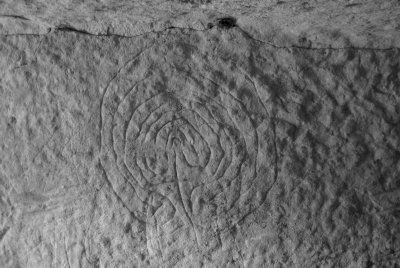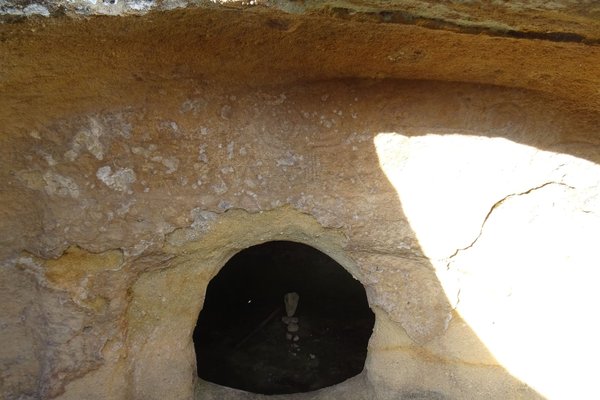Italy
Domus de janas Sardinia
Funerary Tradition in the Prehistory of Sardinia – The domus de janas represents a particular local, prehistoric funerary tradition.
The domus de janas are prehistoric underground funerary structures. There are different types and together they represent the pre-Nuragic cultural system of the 5th-3rd millennium BCE. Some are engraved with elaborate figurative decorative motifs. “Domus de janas” translates to "House of the Fairies", as by legend they were inhabited by magical creatures.
Community Perspective: Visiting the “right” domus de janas is really key here, especially since the list of included components has varied over time. The sites are mostly low-key and you’ll likely be the only visitor.
Site Info
Official Information
- Full Name
- Art and Architecture in the Prehistory of Sardinia – The domus de janas (ID: 1730)
- Country
- Italy
- Status
-
Inscribed 2025
Site history
History of Domus de janas Sardinia
- 2025: Inscribed
- Meets criterion 3
- 2025: Advisory Body overruled
- ICOMOS advised Referral to revise the series and refocus the narrative
- 2021: Added to Tentative List
- Added to tentative list
- Type
- Cultural
- Criteria
- ii
- iii
- vi
Links
- UNESCO
- whc.unesco.org
All Links
UNESCO.org
- whc.unesco.org — whc.unesco.org
Community Information
- Community Category
- Archaeological site: Prehistoric
- Secular structure: Burial
Travel Information
Recent Connections
-
Works by Nobel Prize winning authors
Grazia Deledda (1926) – "Canne al vento…
-
Rock Cut Architecture
"The domus de janas (...) are rock-cut …
-
Recently discovered
Some components were discovered after 1…
Connections of Domus de janas Sardinia
- Trivia
-
-
Pareidolia
Roccia dell'Elefante, shaped like an elephant (Nomination file, p. 233, 305) (Wikipedia)
-
- History
-
-
Megalithism
"testify to the local reinterpretations of two cultural phenomena – hypogeism and megalithism" (AB ev)
-
Neolithic age
"(...) twenty-six component parts , spread across the Italian island of Sardinia, dating from the Middle Neolithic to the Copper Age, up to the dawn of the Bronze Age". (AB Ev)
-
Chalcolithic
"(...) twenty-six component parts , spread across the Italian island of Sardinia, dating from the Middle Neolithic to the Copper Age, up to the dawn of the Bronze Age". (AB Ev)
-
Bronze Age
"(...) twenty-six component parts , spread across the Italian island of Sardinia, dating from the Middle Neolithic to the Copper Age, up to the dawn of the Bronze Age". (AB Ev)
-
- Architecture
-
-
Dry Stone Construction
"Both phenomena (hypogeism and megalithism) resulted in a great number and a variety of examples in the island made using novel construction techniques : (...) not to mention the dry-laid stone construction technique, already found on the island and that has endured to date" (Nomination file, p. 168-170)
-
Cave Temples or Churches
Necropolis of Sant'Andrea Priu: "The transformation of the Tomb of the Chief (VI) into cave church resulted in the site being mentioned in a manuscript dating back to the 11th-12th century." (Nomination file, p. 246)
-
Rock Cut Architecture
"The domus de janas (...) are rock-cut tombs that reflect the funerary practices, spiritual beliefs, and social evolution of Sardinia's prehistoric communities." (Official description) "(...) the chamber tombs carved into the rock, commonly referred to in Sardinian as domus de janas, (...) are the most exceptional pieces of evidence of hypogeism in Sardinia (...)." (Nomination file, p. 183)
-
Made out of basaltic material
Necropolis of Sa Pala Larga: Large funerary chambers carved into the basalt rock (...)." (Link)
-
- World Heritage Process
-
-
Part of Cultural nomination rejected
Components Fortified complex of Monte Baranta (004), Sanctuary of Monte d’Accoddi (006), Necropolis of Li Muri (010), Dolmen of Sa Coveccada (012), Shelter of Luzzanas (013), Village of Serra Linta (017), Grotta Corbeddu (022), Menhir of Monte Corru Tundu (023), Shelter of Su Forru de is Sinzurreddus and the stone tool workshops of Sennixeddu (024) were excluded upon inscription.
-
- Religion and Belief
-
-
Legends and Folk Myths
"the domus de janas and other prehistoric evidence are part of the historical memory of Sardinia evoking myths and legends that still survive in the cultural tradition of the island" (AB ev) – "The wording domus de janas, "House of the Fairies", originated from the stories related to the magical creatures that were believed to inhabit those prehistoric structures. The janas are the main characters of an ancient oral tradition that varies and changes depending on the places, but which consistently always refers to small female stature, endowed with magical powers, benevolent or malevolent and vengeful depending on the stories." (Nomination file, p. 322)
-
Ancestor Worship
"Generally, until the first centuries of the Nuragic civilisation, the sacred is linked to the worship of the ancestors, which is expressed by the creation of collective tombs, erecting menhirs or menhir-statues, and the use of magical-symbolic decorative motifs." (AB Ev + Nomination file, p. 294)
-
- Constructions
-
-
Tombs
the domus de janas are "chamber tombs" (AB ev)
-
Protective Shelters
Necropolis of Monte Siseri: "Of the three known tombs in the necropolis, Tomb I has undergone consolidation, conservative restoration and enhancement. To prevent rainwater and animals from entering in the antechamber, where the ceiling is missing, a protective structure was built in 1990, equipped with a double-sloping tile roof, sealed with a metal hatch." A protective cover was also installed for Tomb XV in the Sos Furrighesos Necropolis. (Nomination file, p. 301, 310)
-
Hypogea
"numerous typical hypogeal structures, known as the domus de janas" (AB ev) – "This serial property is an ensemble of hypogean burials and necropolises located in Sardinia (...) They represent the most extensive and rich manifestation of hypogean funerary architecture in the western Mediterranean, exemplifying a phenomenon attested by approximately 3,500 hypogea spread across the entire island." (Official description)
-
Necropolises
The components include several necropolises
-
- WHS on Other Lists
-
-
Located in a TCC Territory
Sardinia
-
Natura 2000
"Seven component parts (013, 014, 015, 016, 017, 018, 022) are located in the Natura 2000 network." (AB Ev)
-
- Timeline
-
-
Built in the 5th millennium BC
"This serial property is an ensemble of hypogean burials and necropolises located in Sardinia, created between the 5th and 3rd millennia BCE." (Official description)
-
- Science and Technology
-
-
Archaeological potential
Necropolis of Sa Pala Larga (Component 015): "So far, seven tombs have been investigated, those in the northern part of the rocky ridge, and not all of them completely (Tomb IV or Tomba delle Lucerne is largely yet to be investigated). Four tombs, identified on the other side of the pass, are partly concealed by vegetation." - Necropolis of Mandras: "The area, yet to be archaeologically investigated (...)" (Nomination file, p. 252, 264)
-
Recently discovered
Some components were discovered after 1970, e.g. the necropolises of Monte Siseri (1987) and Sa Pala Larga (1997). Seven hypogea were revealed by cleaning operations in the Necropolis of Ispiluncas in 2022. (Nomination file, p. 301, 309, 311)
-
- Literature & Film
-
-
Works by Nobel Prize winning authors
Grazia Deledda (1926) – "Canne al vento" / Deledda references the janas and their houses in her novel: ""Yes, man's working day was done, but the fantastic life of elves, fairies, wandering spirits was beginning. [...] The janas, the little fairies who stay in their small rock houses during the day weaving gold cloth on their golden looms - were dancing in the large phillyrea bushes, while giants looked out from the rocks on the moon-struck mountains." (Nomination file, p. 322)
-
News
No news.
Recent Visitors
Visitors of Domus de janas Sardinia
- Argo
- Astraftis
- Bernard Joseph Esposo Guerrero
- Bram de Bruin
- Bropyk
- CeeMon
- Christian Wagner
- Daniel Chazad
- Dimitar Krastev
- Dwight Zehuan Xiao
- Elia Vettorato
- Eva Kisgyorgy
- H Beswick
- Ivan Rucek
- John Smaranda
- Loic Pedras
- Maciej Gil
- Matejicek
- MAURO PODDA PANI
- MaxHeAnouBen
- nan
- Nasebaer
- Patrik_globe
- Peter Lööv
- Philipp Leu
- Randi Thomsen
- Roger Ourset
- SirLoydd
- Stanislaw Warwas
- Svein Elias
- Szucs Tamas
- Tarquinio_Superbo
- tony0001
- Yevhen Ivanovych
- Zoë Sheng
Community Reviews
Show full reviews
There seems to be an issue in the use of Domus de Janas in this nomination as some components are strictly not rock-hewn tombs. What Italy seems to be gunning for in this nomination is to represent a larger picture of pre-Nuragic cultures of Sardegna, which includes a natural cave considered as "The Cradle of Sardinian Man", structural constructions like altars and dolmens, and even stone tool workshops. If anything, the Domus de Janas are only the most representative monuments from a vast period before the Nuraghes started appearing on the island. I managed to see the Necropoli a Domus de Janas di Brodu (ca. 3,200BC) in Oniferi. My friend and I drove from Barumini heading for Orgosolo, and the entrance to the necropolis was conveniently situated a few kilometers from the highway. I purposely chose to see this necropolis as it has been described as a site where artistic carvings can be seen blending with functional architectural features. In this case, the symbolic ox horns were decoratively placed above the doors, thus the doors became representations of the ox's head. The fusion of these two elements is considered as an artistic milestone, and is referred to in the draft dossier as Transitional Type XIX.
In visiting the site, we had to open three farm gates (these are private properties, but being with a charming local eased things out so we never had any problem with the cork farmers and shepherds we encountered), and walked some 20 minutes …
Keep reading 0 comments
Yesterday and today I visited some sites of the "domus de Janas" sites.
1) Anghelu Ruju near Alghero. This site is rather big with some 40 graves. There is entrance fee, and good explanation.
2) Su Crucifissu Mannu near Porto Torres. This site is near a farm. You can free visit. No entrance fee, no explanation. Not so many graves.
3) Altar of Monte d' Accoddi between Porto Torres and Sassari. This one is not similar at all to the other ones, but in my opinion most interesting site from the ones I saw. It is build in third millennium before Christ.
4) Sennori: near the buildings of the commune; you need to get the key there and return to the same place.
5) Su Murrone in Chiaramonte: in the middle of the fields, no entrance fee, no explanation. Not so many graves.
6) Elefant Domus de Janus in Castel Sordo: one or two domus de janas. Most interesting about this one is the shape of the rock. I think 99 % from the visitors comes for the shape and not for the grave.
7) Necropolis of Montalè in Sassari: not worth the detour. Behind a fence and very small (i think just one).
Conclusion: i am charmed by some of the parts of this "domus de janas"; for me definitely a yes; I would only keep 1) and 3) from this ones.
Keep reading 0 comments
Sardinia boasts arguably the best beaches in Europe as well as countless prehistoric and protohistoric archaeological sites. This TWHS is only about necropoles though, not less than 35 in the description (out of more than 10,000 on Sardinia), and most of them situated in the northwest of the island. As I have not been to that part of the island yet, I have only seen two of the tentative sites: Li Muri near Arzachena and the mysterious Tomba del Labirinto. Both are unique and worth the visit, and the latter could definitely use a protection concept.
Li Muri is situated in the northeast, not far from the famous Costa Smeralda, in a geographic cluster with other interesting megalithic/nuraghic sites. It consists of a series of four concentric funerary circles with vertically placed stones, a central sepulchral compartment and menhirs in the outer circle. It forms part of the Arzachena Archaeological Park along with other interesting sites but the distances between them are a bit too long to walk (and walking along the road certainly is not enjoyable). From the closest to the farthest from Li Muri, the other sites of the archaeological park are: Li Lolghi and Coddu Vecchiu (giants' tombs), La Prisgiona (nuraghe) and Albucciu (protonuraghe). All are worth to visit when in the area.
Tomba del Labirinto (also known as Luzzanas rock tomb) was an adventure to visit more than a decade ago (and probably still is today). At 40°26'11.98"N 9°7'30.87"E, it is situated in the …
Keep reading 0 comments
This is quite interesting serial nomination of 35 pre-historic, pre-Nuraghic sites of Sardinia. Nevertheless, I was thinking intensively how to evaluate it in comparison to other archeological sites in Europe. The killing feature is enormous number of sites and rather scientific description/justification provided by the state party of Italy: They are praising unique combination of hypogeism and megalithism typical for these structures dating to 5th-3rd Millennium BC. Well, maybe yes... However, I like and support megalithic TWHS sites like Carnac in Bretagne, Ceide Fildes and future-TWHSs around Sligo in Ireland. Thus, why not Domus de Janas of Sardinia? This is the reason I change my initial thumb-down to -up for this TWHS, but we will see...
I visited Sardinia in September/October 2017, and I enjoyed my stay very much. From the point of view of UNESCO material, Sardinia is a poor sister of Italian mainland. Besides already inscribed Nuraghe (only one site in this WHS, what about extended by other hundreds of Nuraghic sites...???), I can see a potential only in natural coastal reserves (La Maddalena Archipelago) and these pre-Nuraghic sites that are obviously much older than Nuraghes...
I visited only one site from this nomination: the component No.33 Pranu Mutteddu near Goni village, and it happened by coincidence, I would say. During my Sardinia vacations we explored almost all Eastern cost of the island.
Thus, we passed by the component No.31 "Corbeddu Cave in Oliena" without visiting the site. We could see the mountain range, where …
Keep reading 0 comments
